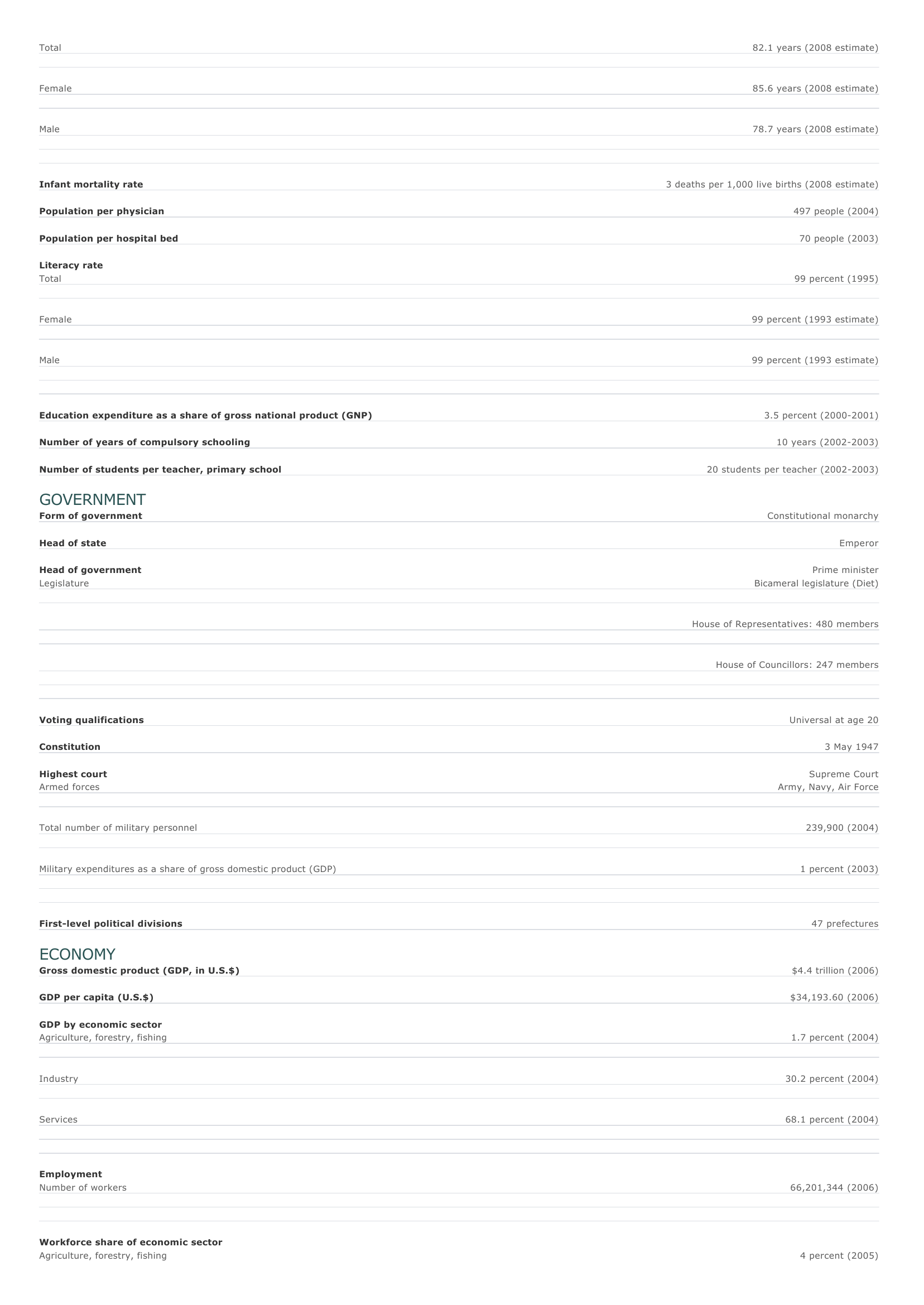Japan Facts and Figures. BASIC FACTS Official name Japan Capital Tokyo Area 377,837 sq km 145,884 sq mi PEOPLE Population 127,288,420 (2008 estimate) Population growth Population growth rate -0.14 percent (2008 estimate) Projected population in 2025 117,816,135 (2025 estimate) Projected population in 2050 93,673,826 (2050 estimate) Population density 340 persons per sq km (2008 estimate) 880 persons per sq mi (2008 estimate) Urban/rural distribution Share urban 66 percent (2005 estimate) Share rural 34 percent (2005 estimate) Largest cities, with population T okyo 8,339,695 (2007) Yokohama 3,562,983 (2007) ? saka 2,510,459 (2007) Nagoya 2,154,287 (2007) Sapporo 1,874,410 (2007) Ethnic groups Japanese Other (mostly Korean), including Ainu 99.4 percent 0.6 percent Languages Japanese (official) Religious affiliations Buddhist 55 percent Christian 4 percent Shintoist 3 percent Nonreligious 10 percent Other (including 'new religions') 28 percent HEALTH AND EDUCATION Life expectancy Total 82.1 years (2008 estimate) Female 85.6 years (2008 estimate) Male 78.7 years (2008 estimate) Infant mortality rate Population per physician Population per hospital bed 3 deaths per 1,000 live births (2008 estimate) 497 people (2004) 70 people (2003) Literacy rate Total 99 percent (1995) Female 99 percent (1993 estimate) Male 99 percent (1993 estimate) Education expenditure as a share of gross national product (GNP) Number of years of compulsory schooling Number of students per teacher, primary school 3.5 percent (2000-2001) 10 years (2002-2003) 20 students per teacher (2002-2003) GOVERNMENT Form of government Head of state Head of government Legislature Constitutional monarchy Emperor Prime minister Bicameral legislature (Diet) House of Representatives: 480 members House of Councillors: 247 members Voting qualifications Constitution Highest court Armed forces Total number of military personnel Military expenditures as a share of gross domestic product (GDP) First-level political divisions Universal at age 20 3 May 1947 Supreme Court Army, Navy, Air Force 239,900 (2004) 1 percent (2003) 47 prefectures ECONOMY Gross domestic product (GDP, in U.S.$) $4.4 trillion (2006) GDP per capita (U.S.$) $34,193.60 (2006) GDP by economic sector Agriculture, forestry, fishing 1.7 percent (2004) I ndustry 30.2 percent (2004) Services 68.1 percent (2004) Employment Number of workers Workforce share of economic sector Agriculture, forestry, fishing 66,201,344 (2006) 4 percent (2005) I ndustry 28 percent (2005) Services 66 percent (2005) Unemployment rate 4.7 percent (2004) National budget (U.S.$) Total revenue $892,795 million (1993) Total expenditure $896,052 million (1993) Monetary unit 1 yen, consisting of 100 sen Agriculture Rice, sugar beets, potatoes, cabbages, citrus fruits, sugarcane, sweet potatoes, onions Mining Limestone, coal, copper, lead, and zinc Manufacturing General and electrical machinery, food and beverages, transportation equipment, chemicals, fabricated metal products, iron and steel, and publishing and printing Major exports Machinery, automobiles, chemicals, steel, and textiles Major imports Machinery and equipment, food, fuels, chemical ores and metals, and agricultural raw materials Major trade partners for exports United States, China, South Korea, Taiwan, and Hong Kong SAR Major trade partners for imports United States, China, South Korea, Indonesia, and Australia ENERGY, COMMUNICATIONS, AND TRANSPORTATION Electricity production Electricity from thermal sources 63.72 percent (2003 estimate) Electricity from hydroelectric sources 10.23 percent (2003 estimate) Electricity from nuclear sources 23.31 percent (2003 estimate) Electricity from geothermal, solar, and wind sources 2.74 percent (2003 estimate) Number of radios per 1,000 people 956 (1997) Number of telephones per 1,000 people 460 (2005) Number of televisions per 1,000 people 728 (2000 estimate) Number of Internet hosts per 10,000 people 1,016 (2003) Daily newspaper circulation per 1,000 people 580 (1996) Number of motor vehicles per 1,000 people 586 (2004) Paved road as a share of total roads 78 percent (2002) SOURCES Basic Facts and People sections Area data are from the statistical bureaus of individual countries. Population, population growth rate, and population projections are from the United States Census Bureau, International Programs Center, International Data Base (IDB) (www.census.gov). Urban and rural population data are from the Food and Agriculture Organization (FAO) of the United Nations (UN), FAOSTAT database (www.fao.org). Largest cities population data and political divisions data are from the statistical bureaus of individual countries. Ethnic divisions and religion data are largely from the latest Central Intelligence Agency (CIA) World Factbook and from various country censuses and reports. Language data are largely from the Ethnologue, Languages of the World, Summer Institute of Linguistics International (www.sil.org). Health and Education section Life expectancy and infant mortality data are from the United States Census Bureau, International Programs Center, International database (IDB) (www.census.gov). Population per physician and population per hospital bed data are from the World Health Organization (WHO) (www.who.int). Education data are from the United Nations Educational, Scientific and Cultural Organization (UNESCO) database (www.unesco.org). Government section Government, independence, legislature, constitution, highest court, and voting qualifications data are largely from various government Web sites, the latest Europa World Yearbook, and the latest Central Intelligence Agency (CIA) World Factbook. The armed forces data is from Military Balance. Economy section Gross domestic product (GDP), GDP per capita, GDP by economic sectors, employment, and national budget data are from the World Bank database (www.worldbank.org). Monetary unit, agriculture, mining, manufacturing, exports, imports, and major trade partner information is from the statistical bureaus of individual countries, latest Europa World Yearbook, and various United Nations and International Monetary Fund (IMF) publications. Energy, Communication, and Transportation section Electricity information is from the Energy Information Administration (EIA) database (www.eia.doe.gov). Radio, telephone, television, and newspaper information is from the United Nations Educational, Scientific and Cultural Organization (UNESCO) database (www.unesco.org). Internet hosts, motor vehicles, and road data are from the World Bank database (www.worldbank.org). Note Figures may not total 100 percent due to rounding. Microsoft ® Encarta ® 2009. © 1993-2008 Microsoft Corporation. All rights reserved.






